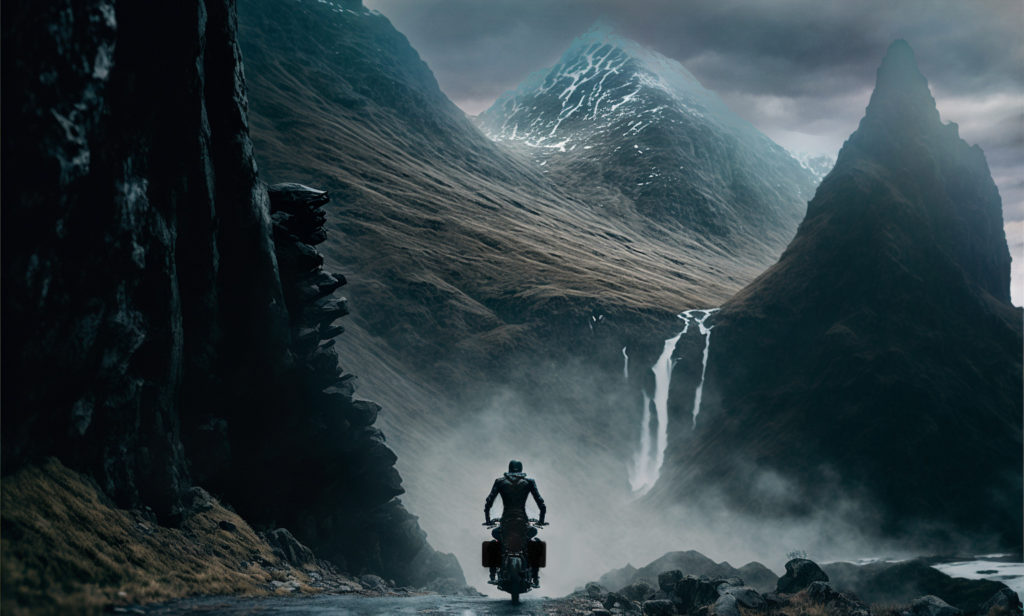A TRIBUTE TO THE GHOST RIDER
SEPTEMBER 12, 1952 - JANUARY 7, 2020
Three years ago today the world lost one of the great ones. Neil Elwood Peart, drummer for the legendary Canadian rock band, Rush; and an Adventure Motorcyclist of the highest order succumbed to Glioblastoma, an aggressive form of brain cancer. He was 67 years old.
More than enough has already been written about the man’s life. Any attempt on my part to write something original, of a biographical nature, would be futile. It’s been done already and done well. Check out a number of great tributes from the likes of Rolling Stone Magazine and NPR on the life and times of the iconic musician; considered by many to be one of the best drummers of all time. Motorcyclists will find his September 2009 interview with the American Motorcyclist Association enlightening and informative.
Introduction To The Ghost Rider
I can only offer my own personal version of what his life, and works, have meant to me. Unlike many, Neil did not come into my field of awareness because of his life as a rock and roll icon. Truth be told I was never a big fan of the music of Rush. I learned of Neil as a motorcyclist. And a writer. And a philosopher. He was brilliant in all of those roles.

I became aware of Neil’s writing at a time in my life when I started to write about some of my own experiences traveling long distance by motorcycle. My first introduction to his prose, like so many others, was his work “Ghost Rider: Travels on the Healing Road”. For those not familiar with the piece it was written over the course of a 15 month long, 55,000 mile motorcycle journey through Canada, Alaska, the American Southwest, Mexico and Central America.
“The Healing Road” portion of the title refers to the trip’s mission; which was to cope with personal tragedy of the highest order. At a peak in his musical career, and at the young age of 45, he lost his 19 year old daughter to an automobile accident. Less than a year later his common law wife of 23 years died of cancer…though Neil would ultimately conclude she died of a broken heart after their child’s death.
Two Wheels In Winter
It’s January 7th as I publish this piece. Most of the North American continent is in the grips of winter. Motorcycles are, for the most part, put up in storage for the frigid months. Motorcyclists in online forums are asking for recommendations for reading materials to help them weather the cold months without two wheels. “Ghost Rider” invariably shows up as one of the premier suggestions. I, also, would highly recommend this volume, but be forewarned that the book has very dark overtones for obvious reasons.
In a recent blog post here on Roadcraft USA we explored the question “Why Do You Ride?” The response to that feature was overwhelming. Many of the responses revolved around the therapeutic benefits of motorcycle riding…derived during the quality time that a rider spends with their own thoughts when in the saddle. A bit of a spoiler here: “Ghost Rider” eventually ends with a semblance of a happy ending and Peart described the benefits of riding for one’s sanity as well as anyone ever has:
“…when I set out on my journey, I was driven by a sense, or a hope, that motion would be a good “diversion” for me, especially compared to sitting here and stewing in my own bile, but I had no idea just how important it would be. Some mornings I would wake up freaking and sad and lonely and desperate, but as soon as I got on the bike, the world would first contract, to the size of the machine which carried me and everything I needed; and then it would expand, to the wide new world of highway, landscape, and wildlife coming at me.”
Recommended Reading
Neil Peart returned to his career as a musician and went on to write much, much more over the next 20 years of his life. His claim to fame as a motorcyclist revolved around the concert tours with Rush. While his bandmates, Geddy Lee and Alex Lifeson, would travel between concert venues in the “Rock Star” style of their private jet, Neil would travel between destination cities in the saddle of one of his BMW GS motorcycles. His travels always took him on the roads less traveled…roads that “no one drives unless they live on them”.

His two-wheeled concert tour travels, ultimately totaling more than 300,000 miles are documented in his follow up works:
By the time you finish reading all of these books (and you’ll probably read them more than once) you will feel as if you knew the man as well as anyone did. And what an extraordinary man he was. Not a single moment seemed to go to waste in his entire lifetime. Everything he did, he did with a passion and intensity that few people could ever claim.

A Breed Apart
Neil was an adventurer’s adventurer. Given the choice between riding 12 hours in cold, miserable weather or spending five hours on a comfortable tour bus (or an hour on a luxury Learjet) the choice would always be the motorcycle. The words “Live To Ride” were not a cliché to this man…they truly were his way of life.

When Rush was planning yet another concert tour in their 40+ year long tenure, Neil would start practicing six months beforehand, for six hours daily. Alone…in the confines of a small rental rehearsal studio somewhere. Because: perfection.
Between tours Peart would keep himself in peak physical condition engaging in demanding sports such as rowing, snowshoeing, hiking, cross country skiing, bicycling, climbing and swimming. He would spend every possible moment he could with his daughter, Olivia (from his second marriage to Carrie Nuttall, a commercial photographer, whom he met through a mutual friend in 1999).
Live While You’re Alive

His zest for life, and getting the most out of it, can be summed up in this quote from his book “Far and Near: On Days Like These”:
“I have never liked the clichés about time racing by, because I think you simply have to keep up with that pace—live your life at exactly the speed of time. Anyone asking, “Where did the time go?” obviously wasn’t paying attention! Each day, week, month, or year is a vessel of fixed capacity, to be filled with memorable incidents and stories”.
This statement obviously shows his growth, over time, as a writer and a student of life itself. In an earlier quote from “Far and Away: A Prize Every Time” he simply admonished his readers to:
“Wake up every morning like it’s the last day of your life.
Go to sleep at night like you’re gonna live forever.”
Three years ago, today, we lost Neil. Folks will say he was taken from us far too soon. He was 67 years old and lived every single moment of his life to the absolute fullest. I’m not sure what else anyone…even Neil…could have asked for.

Click Here to view an interactive visual index page where you can quickly browse through all of the great features that are published on the Roadcraft USA blog. Be sure to subscribe to Roadcraft USA to stay up to date. We send out occasional email notifications when new features hit the blog.
Please help support the Roadcraft USA online resource by making product purchases through the links in this post. As Amazon Associates we earn commissions from qualifying purchases made through these links. There is no additional cost to you whatsoever. Thank you for your support!


Neil was also a consummate car guy. Some of the classic cars in his collection were an Aston Martin DB5, Maserati Mistral and Lamborghini Miura. He writes about his love of taking a solo drive in his book, “Traveling Music: The Soundtrack to My Life and Times”. It’s another good read.
Very true, Deborah. He referred to his collection of autos as “The Silver Surfers” (They were all silver in color…and it was quite the impressive collection). Traveling Music is a great read for anyone who would like to know more about the musical influences on Neil’s life. Thanks for commenting!
In peace, brother.